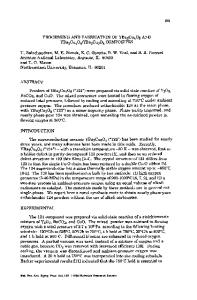Microstructure and Properties of Mixed Yba 2 Cu 3 O 7 -X and Y 2 Ba 4 Cu 8 O 16 Thin Films
- PDF / 1,588,906 Bytes
- 4 Pages / 420.48 x 639 pts Page_size
- 11 Downloads / 399 Views
MICROSTRUCTURE AND PROPERTIES OF MIXED YBA2CU307_X AND Y2BA4CU8016 THIN FILMS. A.F. Marshall*, A. Kapitulnik*, K. Char** and R.W. Barton** *Center for Materials Research and Dept. of Applied Physics, Stanford University, Stanford,
CA 94305
"**Conductus, Inc., Sunnyvale,
CA 94086
ABSTRACT Post-annealed thin films comprised of mixed YBa2Cu307_x (123) and Y2 Ba 4 Cu 8 0 1 6 (248) phases with both faulted and unfaulted microstructures have been characterized by planar and cross-section transmission electron microscopy. The influence of 248-type faults on the 123 structure, possible mechanisms for the higher Tc's of faulted films, and observations of a fourfold ordered structure are discussed. INTRODUCTION The most frequent stacking variation observed in the YBa 2 Cu307_x (123) phase is the occurrence of an extra Cu-O layer between the Ba layers, forming a double Cu-O layer with a shift of 1/2 b between them [1]. An ordered array of this "defect" forming a new phase, Y2 Ba 4 CusO 1 6 (248) was first observed to occur in post-annealed thin films [21 and was subsequently synthesized as a majority phase and found to be superconducting [3,4]. Other stacking variations observed in the 123 structure include the 247-type ordering (which also forms an ordered superconducting phase [5]) where the double Cu-O layers occur every two unit cells of 123, and the more recently characterized "224" stacking fault [6]. The latter structure is proposed to have an extra Y layer between double Cu-O layers, a defect structure originally observed and modeled by Ourmazd et al [7]. The occurrence of these stacking variations is of great interest both because they form new superconducting phases and because the defect structure of superconducting materials is very important in controlling properties such as pinning. Although bulk 123 often does not exhibit a high density of stacking faults, such faults are ubiquitous in thin films which are made by a variety of techniques. In Cu-rich (relative to 123) post-annealed thin films, annealed at or below 850°C, x-ray diffraction shows the presence of both the 123 and 248 phases, which may or may not be highly faulted. X-ray patterns of Cu- and Y-rich in situ films on the other hand generally show only the presence of 123 and randomly oriented non-superconducting second phases. Transmission electron microscopy (TEM), however, shows the presence of 248 and sometimes "224" faults in both types of films sometimes in high density. 224 type faults have also been observed to form an ordered array over small areas in both types of films. In this paper we will report on characterization by transmission electron microscopy (TEM) of stacking faults and ordered stacking fault arrays in post annealed thin films. The characterization of stacking faults in in situ films will be reported elsewhere. RESULTS AND DISCUSSION Post-annealed thin films (one hour at 850°C, slow cooling in air) made by co-evaporation onto an array of (100) SrTiO3 substrates show small systematic variations in compostion with position relat
Data Loading...











